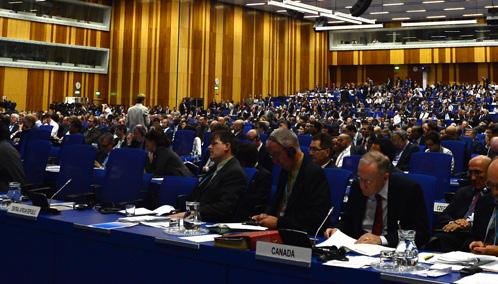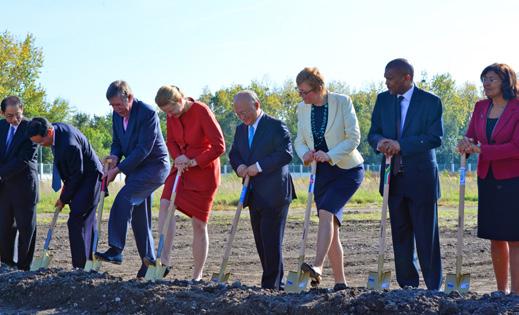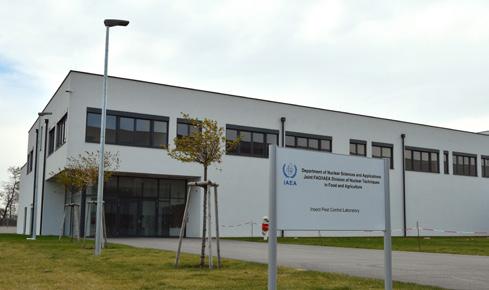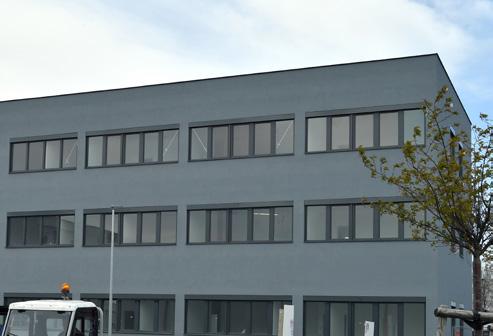
4 minute read
IAEA launches new phase in renovations to build labs
— Najat Mokhtar, Deputy Director General, IAEA
IAEA launches new phase in renovations to build labs fit for the future
By Wolfgang Picot
An extensive renovation project, called ReNuAL is entering a new phase to provide the IAEA Secretariat — and Member States — with state-of-the-art facilities for the remainder of its eight nuclear applications laboratories in Seibersdorf, Austria. Thanks to contributions totalling nearly €40 million, raised partially through the Peaceful Uses Initiative (PUI), for the first two stages of the project, four of the eight laboratories are now housed in new buildings and a fifth has a new linear accelerator (linac) facility.
In September 2020, IAEA Director General Rafael Mariano Grossi launched ReNuAL 2 to modernize the remaining laboratories, at an estimated cost of approximately €34.5 million.
Located near Vienna, the laboratories offer specialized support to countries around the world. “The eight IAEA nuclear applications laboratories in Seibersdorf provide unique services to all of our 172 Member States in applied research, training and specialist support in food and agriculture, human health, environmental monitoring, the use of nuclear analytical instrumentation and many other areas,” Mr Grossi said.
Examples of the laboratories’ activities include assistance in cancer care, help in developing more efficient agriculture, including more productive and resilient crops and research on human and zoonotic diseases. Most recently, the IAEA supported more than 120 countries and territories in the use of nuclear-related reverse transcription–polymerase chain reaction (RT–PCR) technology for the detection of COVID-19 infections.
ReNuAL 2 will include the construction of a new building to house the Terrestrial Environment Laboratory, the Plant Breeding and Genetics Laboratory and the Nuclear Science and Instrumentation Laboratory. It will also replace the IAEA’s ageing greenhouses. These facilities are essential for the IAEA’s work on climate-smart agriculture, water resources management and food security. Furthermore, ReNuAL 2 will provide for the complete refurbishment of the Dosimetry Laboratory, which will stay in the building it currently occupies. Dosimetry is essential to ensure that cancer patients receive safe radiation doses.
ReNuAL reached its latest milestone in June 2020 when Director General Grossi opened The Yukiya Amano Laboratories building. The facility is named after the late former Director General Yukiya Amano, who had worked tirelessly to realize the renovation of the Seibersdorf laboratories. The building houses the Animal Production and Health
September 2013
The General Conference calls for the modernization of the nuclear applications laboratories. September 2014
Symbolic groundbreaking ceremony for the ReNuAL project.

September 2017
A new building housing the Insect Pest Control Laboratory (IPCL) inaugurated.

Laboratory, the Food and Environmental Protection Laboratory, and the Soil and Water Management and Crop Nutrition Laboratory. They help countries in agriculture, food security and natural resource management and support them in addressing zoonotic diseases such as COVID-19, avian influenza, Ebola and Zika virus disease.
Major milestones of the project included an initial upgrade of the Dosimetry Laboratory, as well as the opening of a new Insect Pest Control Laboratory (IPCL) in 2017 and a new linac facility in 2019.
The linac bolsters the IAEA’s capacity to carry out dosimetry calibration and dose audits and supports its activities in cancer control. The linac is also used for research and to train professionals from around the world.
With over 1700 square meters of laboratory space, the modernized IPCL substantially increases the IAEA’s ability to assist Member States in applying the sterile insect technique (SIT). For over five decades, the SIT has been successful in controlling several harmful insect pests. It is among the most environmentally friendly insect pest control methods developed.
The activities of the labs make them a guiding institution for the international nuclear science community and are essential to the IAEA’s work to help Member States achieve the Sustainable Development Goals (SDGs). The nuclear applications laboratories have long-standing strategic partnerships with the World Health Organization and the World Organisation for Animal Health and work with key academic and research institutions and reference laboratories around the world. Five of the labs are managed through a partnership with the Food and Agriculture Organization of the United Nations (FAO).
When the Seibersdorf Complex opened in 1962 with fewer than 40 staff members, only a limited number of countries and sectors used nuclear technologies. Since then the world has changed. Today, nuclear and nuclear-derived techniques are used across the globe for an unprecedented range of applications touching on all aspects of human existence. The number of IAEA Member States has more than doubled since the laboratories’ inception, and their needs are evolving as new challenges emerge.
To address the rising number of requests and ensure services are of the highest quality, the labs need appropriate infrastructure. The number of staff grew to around 100 over time, but facilities and equipment had never received a comprehensive upgrade. As a result, the nuclear applications labs were increasingly struggling to meet demand.
“The modernization of the laboratories represents a critical investment in the IAEA’s ability to address the needs of Member States,” said Najat Mokhtar, IAEA Deputy Director General and Head of the Department of Nuclear Sciences and Applications. “ReNuAL 2 will further improve their ability to achieve development goals and meet new challenges in the years to come.”
June 2019
The new linac facility opens.

June 2020
The Yukiya Amano Laboratories open. September 2020

IAEA Director General Rafael Mariano Grossi launches ReNuAL 2.










